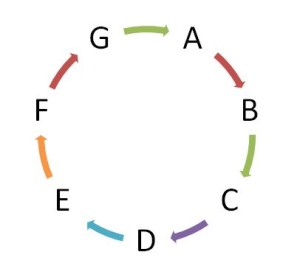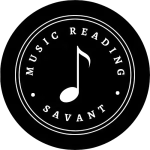| This reading music lesson is a supplement to the Alfred’s Essentials of Music Theory self-study workbook. While no book is perfect for learning how to read music, this is one of the best available. The concise explanations, brief practice exercises, ear-training CD’s, glossary of music terms, and answer key make it an excellent value. Buy this top-rated self-study course for beginners to advanced musicians and follow along with me. |
What is the Music Alphabet?
The music alphabet is not too different from the American English alphabet.
The best part is that it only uses the first 7 letters.

When those seven letters are done, it restarts all over again.
We begin with “A” and move in order of the alphabet and stop at “G”. That’s it!
That’s all of the letters we use to name notes.
Once you hit G, you restart back over with “A”.

Around and around we go cycling through the alphabet over and over again.
This reminds me of the merry-go-round at the park. The letters take their place and enjoy the ride.
No one wants to jump off because their having too much fun.
Is anybody getting dizzy yet?
Anyways, the next thing we’re going to do is start learning how this applies to the notes on the music staff.
But first, we need to have a brief lesson on clef signs. Go now to Clef Signs – Reading Music Lesson #7
